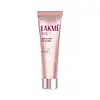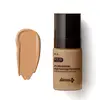What's inside
What's inside
 Key Ingredients
Key Ingredients

 Benefits
Benefits

 Concerns
Concerns

 Ingredients Side-by-side
Ingredients Side-by-side

Water
Skin ConditioningCyclopentasiloxane
EmollientEthylhexyl Methoxycinnamate
UV AbsorberZinc Oxide
Cosmetic ColorantTitanium Dioxide
Cosmetic ColorantGlycerin
HumectantNiacinamide
SmoothingDimethicone Crosspolymer
Emulsion StabilisingPotassium Chloride
CI 77492
Cosmetic ColorantDicaprylyl Carbonate
EmollientPEG-10 Dimethicone
Skin ConditioningMagnesium Sulfate
Cyclomethicone
EmollientParfum
MaskingCI 77491
Cosmetic ColorantDisteardimonium Hectorite
StabilisingTriethoxycaprylylsilane
Palmitic Acid
EmollientStearic Acid
CleansingCyclotetrasiloxane
EmollientBisabolol
MaskingZingiber Officinale Root Extract
MaskingCholesterol
EmollientDMDM Hydantoin
PreservativeCI 77499
Cosmetic ColorantSucrose Distearate
EmollientAlumina
AbrasiveAllantoin
Skin ConditioningTocopheryl Acetate
AntioxidantDimethicone
EmollientDisodium EDTA
Butylene Glycol
HumectantIodopropynyl Butylcarbamate
PreservativeButylphenyl Methylpropional
PerfumingHexyl Cinnamal
PerfumingLinalool
PerfumingBenzyl Salicylate
PerfumingCitronellol
PerfumingBenzyl Acetate
MaskingLimonene
PerfumingAmyl Cinnamal
PerfumingCitral
PerfumingWater, Cyclopentasiloxane, Ethylhexyl Methoxycinnamate, Zinc Oxide, Titanium Dioxide, Glycerin, Niacinamide, Dimethicone Crosspolymer, Potassium Chloride, CI 77492, Dicaprylyl Carbonate, PEG-10 Dimethicone, Magnesium Sulfate, Cyclomethicone, Parfum, CI 77491, Disteardimonium Hectorite, Triethoxycaprylylsilane, Palmitic Acid, Stearic Acid, Cyclotetrasiloxane, Bisabolol, Zingiber Officinale Root Extract, Cholesterol, DMDM Hydantoin, CI 77499, Sucrose Distearate, Alumina, Allantoin, Tocopheryl Acetate, Dimethicone, Disodium EDTA, Butylene Glycol, Iodopropynyl Butylcarbamate, Butylphenyl Methylpropional, Hexyl Cinnamal, Linalool, Benzyl Salicylate, Citronellol, Benzyl Acetate, Limonene, Amyl Cinnamal, Citral
Water
Skin ConditioningCyclopentasiloxane
EmollientCI 77891
Cosmetic ColorantAluminum Hydroxide
EmollientTriethoxycaprylylsilane
Octocrylene
UV AbsorberEthylhexyl Methoxycinnamate
UV AbsorberIsododecane
EmollientTitanium Dioxide
Cosmetic ColorantSimethicone
EmollientAlumina
AbrasivePolyglyceryl-4 Isostearate
EmulsifyingCetyl PEG/PPG-10/1 Dimethicone
EmulsifyingSqualane
EmollientButylene Glycol
HumectantHydrogenated Didecene
Skin ConditioningNiacinamide
SmoothingSilica Dimethyl Silylate
EmollientDisteardimonium Hectorite
StabilisingCI 77492
Cosmetic ColorantLauroyl Lysine
Skin ConditioningSodium Chloride
MaskingPhenoxyethanol
PreservativeTropolone
Skin ConditioningCI 77491
Cosmetic ColorantSodium Dehydroacetate
PreservativeSodium Gluconate
Skin ConditioningSodium Hyaluronate
HumectantCI 77499
Cosmetic ColorantWater, Cyclopentasiloxane, CI 77891, Aluminum Hydroxide, Triethoxycaprylylsilane, Octocrylene, Ethylhexyl Methoxycinnamate, Isododecane, Titanium Dioxide, Simethicone, Alumina, Polyglyceryl-4 Isostearate, Cetyl PEG/PPG-10/1 Dimethicone, Squalane, Butylene Glycol, Hydrogenated Didecene, Niacinamide, Silica Dimethyl Silylate, Disteardimonium Hectorite, CI 77492, Lauroyl Lysine, Sodium Chloride, Phenoxyethanol, Tropolone, CI 77491, Sodium Dehydroacetate, Sodium Gluconate, Sodium Hyaluronate, CI 77499
 Reviews
Reviews

Ingredients Explained
These ingredients are found in both products.
Ingredients higher up in an ingredient list are typically present in a larger amount.
Alumina is another name for the compound aluminum oxide. It is used as a thickener, absorbent, and abrasive.
As an absorbent, alumina can give a mattifying effect. It is used in mineral sunscreens to help coat nano-sized filters, such as titanium dioxide. By increasing the size of the UV filters, these ingredients stay on the skin for a longer time. By coating small sized ingredients, alumina helps thicken a product.
Alumina may be used as an abrasive, or exfoliant.
Alumina is naturally occurring in the mineral corundum. Certain varieties of corundum create rubies and sapphires. Corundum is also the crystalline form of alumina.
Learn more about AluminaButylene Glycol (or BG) is used within cosmetic products for a few different reasons:
Overall, Butylene Glycol is a safe and well-rounded ingredient that works well with other ingredients.
Though this ingredient works well with most skin types, some people with sensitive skin may experience a reaction such as allergic rashes, closed comedones, or itchiness.
Learn more about Butylene GlycolCi 77491 is also hydrated iron III oxide. It's sole purpose is to give a red/pink hue to products.
Iron III oxides are classified as inorganic chemicals for coloring.
Synthetically created Ci 77491 is considered safer than those naturally found. This is because the synthetically created version may contain less impurities. Iron oxides are generally non-toxic and non-allergenic.
Learn more about CI 77491Ci 77492 is also hydrated iron III oxide. It's sole purpose is to give a yellow hue to products.
Iron III oxides are classified as inorganic chemicals for coloring.
Synthetically created Ci 77492 is considered safer than those naturally found. This is because the synthetically created version may contain less impurities. Iron oxides are generally non-toxic and non-allergenic.
Learn more about CI 77492Ci 77499 is also hydrated iron III oxide. It is created from mixing red and black iron oxides. This helps give shades of darkness to a product.
Iron III oxides are classified as inorganic chemicals for coloring.
Cyclopentasiloxane, or D5, is a silicone used to improve texture of products and trap moisture.
D5 is considered lightweight and volatile. Volatile means it evaporates quickly after application. Once evaporated, D5 leaves a thin barrier that helps keep skin hydrated.
It is also an emollient. Emollients help soften the skin and prevent water loss. Silicones create a silky texture in products. D5 helps other ingredients become more spreadable.
Studies show D5 is safe to use in skincare products. We recommend speaking with a skincare professional if you have concerns.
Learn more about CyclopentasiloxaneDisteardimonium Hectorite comes from the clay mineral named hectorite. It is used to add thickness to a product.
It can also help stabilize a product by helping to disperse other ingredients.
Hectorite is a rare, white clay mineral.
Learn more about Disteardimonium HectoriteEthylhexyl Methoxycinnamate is an organic compound that provides UVB protection. It often goes by the more common name of octinoxate. It is created from methoxycinnamic acid and 2-ethylhexanol.
Ethylhexyl Methoxycinnamate absorbs UVB rays with wavelengths between 280-320 nm. UV absorbers protect your skin by using chemical reactions to convert UV rays into heat and energy.
UVB (290-320 nm) rays emit more energy than UVA rays. They are capable of damaging DNA, causing sunburns and are thought to be linked to skin cancer.
The state of Hawaii has banned sunscreens containing octinoxate due to its potential impact on coral reefs. More research is needed to bridge gaps in this research. The European Union allows higher levels of octinoxate in sunscreens than the US and Australia.
Ethylhexyl Methoxycinnamate is oil soluble. It is not stable and may lose efficacy when exposed to sunlight.
Learn more about Ethylhexyl MethoxycinnamateNiacinamide is a multitasking form of vitamin B3 that strengthens the skin barrier, reduces pores and dark spots, regulates oil, and improves signs of aging.
And the best part? It's gentle and well-tolerated by most skin types, including sensitive and reactive skin.
You might have heard of "niacin flush", or the reddening of skin that causes itchiness. Niacinamide has not been found to cause this.
In very rare cases, some individuals may not be able to tolerate niacinamide at all or experience an allergic reaction to it.
If you are experiencing flaking, irritation, and dryness with this ingredient, be sure to double check all your products as this ingredient can be found in all categories of skincare.
When incorporating niacinamide into your routine, look out for concentration amounts. Typically, 5% niacinamide provides benefits such as fading dark spots. However, if you have sensitive skin, it is better to begin with a smaller concentration.
When you apply niacinamide to your skin, your body converts it into nicotinamide adenine dinucleotide (NAD). NAD is an essential coenzyme that is already found in your cells as "fuel" and powers countless biological processes.
In your skin, NAD helps repair cell damage, produce new healthy cells, support collagen production, strengthen the skin barrier, and fight environmental stressors (like UV and pollution).
Our natural NAD levels start to decline with age, leading to slower skin repair, visible aging, and a weaker skin barrier. By providing your skin niacinamide, you're recharging your skin's NAD levels. This leads to stronger, healthier, and younger looking skin.
Another name for vitamin B3 is nicotinamide. This vitamin is water-soluble and our bodies don't store it. We obtain Vitamin B3 from either food or skincare. Meat, fish, wheat, yeast, and leafy greens contain vitamin B3.
The type of niacinamide used in skincare is synthetically created.
Learn more about NiacinamideTitanium dioxide is a mineral UV filter widely used in sunscreens and cosmetics.
It is one of only two UV filters officially classified as “mineral” by regulatory agencies, the other being zinc oxide.
Titanium dioxide provides broad-spectrum protection mostly in the UVB and UVAII range, with some protection in the UVAI range.
While its UVA protection isn’t as strong as zinc oxide’s, the difference is minor.
A common myth is that mineral UV filters reflect UV light. However, modern research shows titanium dioxide absorbs UV radiation like chemical filters (~95% absorption & 5% reflection).
Thanks to its non-irritating nature, titanium dioxide is suitable for sensitive, acne-prone, or redness-prone skin. It is unlikely to cause "eye sting" like other sunscreen ingredients.
A major drawback of this ingredient is its white cast and thick texture. This is why mineral sunscreens often leave a white cast and are less cosmetically elegant than chemical/hybrid sunscreens.
To improve white cast and spreadability, micronized or nano-sized titanium dioxide is often used.
There are ongoing concerns surrounding nano-titanium oxide's impact on marine ecosystems.
There is no conclusive evidence that any form of titanium oxide (or any other sunscreen ingredients) will cause harm to marine ecosystems or coral reefs. The science is still developing but many consumers are keeping a close eye on this issue.
Please note, many destinations have reef-safety sunscreen rules. For instance, the U.S. Virgin Islands advises all visitors to use non-nano mineral sunscreens.
Nano mineral sunscreens once raised safety concerns about absorption into skin.
Extensive research has shown that they do not penetrate healthy or damaged skin; they remain safely on the surface and the top layer of dead skin (stratum corneum).
You'll likely find titanium dioxide bundled with alumina, silica, or dimethicone. These ingredients help make titanium dioxide highly photostable; this prevents it from interacting with other formula components under UV light.
Learn more about Titanium DioxideTriethoxycaprylylsilane is a silicone used to bind and stabilize ingredients.
As an emulsifier, it helps prevent ingredients from separating. This can help elongate the shelf life of products.
Triethoxycaprylylsilane is often used to coat mineral sunscreens ingredients to help give a better feel. It also helps reduce oxidative stress in sunscreens.
Learn more about TriethoxycaprylylsilaneWater. It's the most common cosmetic ingredient of all. You'll usually see it at the top of ingredient lists, meaning that it makes up the largest part of the product.
So why is it so popular? Water most often acts as a solvent - this means that it helps dissolve other ingredients into the formulation.
You'll also recognize water as that liquid we all need to stay alive. If you see this, drink a glass of water. Stay hydrated!
Learn more about Water